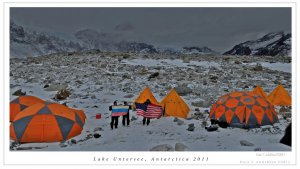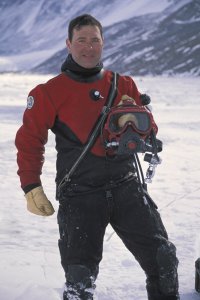
 He lives with his wife, Sasha, and daughter, Masha, in Lake Placid.
He lives with his wife, Sasha, and daughter, Masha, in Lake Placid.
Lake Untersee, first mapped by the Germans in 1931, is a large fresh water lake in Antarctica, 2,600 mikes from human civilization, where the wind reaches over 100 miles per hour and the temperature drops to 20 bellow zero Fahrenheit. The permanently frozen lake is located in the mountains of Queen Maud Land in Antarctica and is one of the most remote and isolated dive sites in the world..
Why, would anyone choose a place like that for scientific exploration?
"Because, our research seeks to understand how microbial life is able to exist in extreme environments on Earth and we use the resulting scientific findings to better understand Earth‘s earliest biosphere and to help guide the search for life elsewhere such as on the planet Mars or the moons of Jupiter and Saturn,” Andersen was quoted saying.
Dale Andersen is a graduate of Virginia Tech. His mentor, George Simmons, a limnologist, led many of the early discoveries within the Antartic lakes, and together with colleagues from William & Mary-affiliated VIMS, began looking at nutrient influx into the Chesapeake Bay, via groundwater.
Serving as a Senior Scientist at SETI Institute’s Carl Sagan Center for the Study of Life in the Universe, Andersen focuses his research on microbial ecosystems in extreme environments, such as areas of the Artic, Antarctic, Atacama Desert, Death Valleys, and Siberia.
During a recent expedition to Lake Untersee, and spending two months exploring the lake, a great deal of it under ten feet of ice, in freezing water, and just before heading home, Andersen’s team made what he calls, "the single-most important observation.” It was the discovery of large conical stromatolites growing on the bottom of the lake.
"As far as we know, these are the only modern analogs to similar large microbial structures that formed as far back as 3.45 billion years ago, at the dawn of life on our planet,” Andersen said in an interview with the Lake Placid News and The Virginia Gazette.
Andersen has become a trailblazer in developing new scientific methods and techniques in the field of how to carry out high quality scientific research in extreme climatic conditions. He was also one of the numbers of NASA exobiology scientists who developed cooperative projects, with their Soviet counterparts. In Andersen’s case, they initiated a scientific program that included working together in a remote region of Antarctica. His association with Vatery Galchenko, the head of the Winongradsky Institute of Microbiology in Moscow, started in 1987, and since than they have spent five field seasons working together in Antarctica.
In fact, Andersen’s team, that usually consist of six to eight international scientist from the USA, Russia, Canada, New Zealand and Austria, made the discovery of the unique microbial life in Lake Untersee, a phenomena that is found nowhere else on the modern planet.
"Our work is a journey of discovery – one that encompasses adventure, curiosity, imagination, leadership and courage along with a burning desire to advance knowledge,” he said.
The long-term cooperation with Russian scientists yielded more than just important scientific data, to Andersen. In 1991, to get his team to the research site at the Bunger Hills, it took two months to circumnavigate half of the Antarctica continent. They did so, on the Soviet icebreaker, "Akademic Fedorov.” During the voyage he met his future wife, Sasha, a Russian, scientists. "When we started our voyage, it was under the Soviet flag, when we returned 4 ½ months later, we sailed under the Russian flag.”
There was also another event that sticks in Andersen’s mind.
"My group and the Russian scientists spent more than four months camped in a very, very remote area. Up until that time we had not had much opportunity for interaction with them because of Cold War tensions. Although, I have spent many seasons in Antarctica, this was a very different experience. When the icebreaker Fedorov departed, we were left alone, completely, without any chance of immediate rescue. We were totally reliant on what we had brought with us and upon one another. Our lives depended on success… During our trip the Soviet Union dissolved, and Russia was born” Andersen said.
More: The SETI Institute is currently having a fundraising campaign that highlights the work at Lake Untersee, if you would like to help support this fascinating research, visit:http://daleandersen.seti.org




.jpg/250px-ElbeDay1945_(NARA_ww2-121).jpg)





